Short-term solutions to squeezing ground at Agnew Gold Mine, Western Australia

|
Authors: Woolley, CE; Andrews, P |
DOI https://doi.org/10.36487/ACG_rep/1511_09_Woolley
Cite As:
Woolley, CE & Andrews, P 2015, 'Short-term solutions to squeezing ground at Agnew Gold Mine, Western Australia', in Y Potvin (ed.), Design Methods 2015: Proceedings of the International Seminar on Design Methods in Underground Mining, Australian Centre for Geomechanics, Perth, pp. 199-214, https://doi.org/10.36487/ACG_rep/1511_09_Woolley
Abstract:
The Waroonga Underground Complex (Agnew Gold Mine) utilises the longhole open stoping method to extract ore from a quartz breccia zone. The Lode 1 ore zone dips west at approximately 65° and sits between a geological hanging wall (HW) made up of a sandstone unit and geological footwall (FW) made up of altered sandstone/ultramafic rock units. During 2014, Lode 1 transitioned from a V-shaped mining front to an M, or inverted double V, mining front. No deviation from the existing ground conditions was observed during transition from V to M front. When production began at 1,180 m below surface reduced level (RL) (Level 1), a higher degree of deformation was observed in the FW and HW shoulder of this level and the four levels below (Levels 25) than had been previously seen. This study outlines the monitoring, modelling, testwork and short-term strategies put in place to ensure that potential impacts to personnel, safety and production are minimised while longerterm solutions to squeezing ground are examined. Monitoring includes extensometer pins installed over two levels, with profile survey points also included in the lowermost level. Photographic monitoring stations are established in all active development/production levels. The initial numerical modelling undertaken included 2-dimensional finite element and kinematic analysis to ensure that the ground support used would achieve the required Factor of Safety (FS). Preliminary observations indicate that regional faults in the ore zone play a significant part in level of FW deterioration with the majority of squeezing occurring between the ‘Thresher’ fault and ‘Sandbar’ fold in the northern part of the ore drives. Testwork commissioned on core samples from the affected ore drives focused on mineralogy testing. Alteration mineral type and abundance in FW rock units are hypothesised to be influencing squeezing behaviour. Where deformation has occurred in levels ahead of stoping, they have been signed off and rehabilitation is conducted just prior to production requirements. It is believed that further modelling and trials of ground support systems/elements, possibly in conjunction with changes to extraction sequence, are required to mitigate squeezing conditions in the longer term, with ground support being varied according to likelihood of squeezing. However, it is believed that the current strategy of monitoring and signing off affected areas before justintime rehabilitation is an adequate shortterm solution.
References:
Mercier-Langevin, F & Hadjigeorgiou, J 2011, ‘Towards a better understanding of squeezing potential in hard rock mines’, Mining Technology Journal, vol. 120, no. 1, pp. 36-44.
Mercier-Langvin, F & Wilson, D 2013, ‘Lapa Mine – ground control practices in extreme squeezing ground’, in Y Potvin (ed.), Proceedings of the Seventh International Symposium on Ground Support in Mining and Underground Construction (Ground Support 2013), Australian Centre for Geomechanics, Perth, pp. 119-133.
Potvin, Y & Hadjigeorgiou, J 2008, ‘Ground support strategies to control large deformations in mining excavations, Journal of the Southern African Institute of Mining and Metallurgy, vol. 108, pp. 393-400.
© Copyright 2025, Australian Centre for Geomechanics (ACG), The University of Western Australia. All rights reserved.
View copyright/legal information
Please direct any queries or error reports to repository-acg@uwa.edu.au
View copyright/legal information
Please direct any queries or error reports to repository-acg@uwa.edu.au